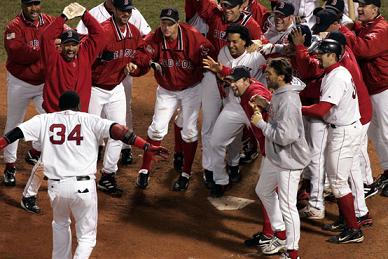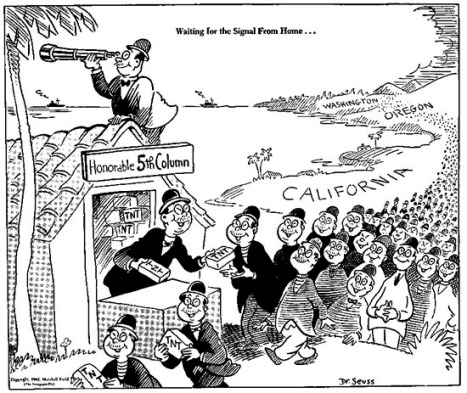 Over the past few months, we have grown accustomed to articles in newspapers and magazines addressing the psychological problems our veterans are dealing with. No matter whether or not we support the war in Iraq, all Americans empathize with the soldiers, hoping that they receive the care necessary to have a promising future. However, there is relatively little attention paid to the psychological impact the war has had on the Iraqi people, particularly the children. Their suffering is less salient and, as an “outgroup,” many Americans may subconsciously trivialize their suffering.
Over the past few months, we have grown accustomed to articles in newspapers and magazines addressing the psychological problems our veterans are dealing with. No matter whether or not we support the war in Iraq, all Americans empathize with the soldiers, hoping that they receive the care necessary to have a promising future. However, there is relatively little attention paid to the psychological impact the war has had on the Iraqi people, particularly the children. Their suffering is less salient and, as an “outgroup,” many Americans may subconsciously trivialize their suffering.
Our disappointment with the fact that the returning U.S. veterans are receiving too little care offers perspective on the amount of help the war-torn Iraqi state can offer their children, who have been exposed to all sorts of violence since Shock & Awe. Iraqi’s are beginning to question what lies in store for the future of Iraq and what this will mean when today’s youth becomes tomorrow’s leaders? A Washington Post article, excerpted below, examines these important questions.
* * *
Marwa Hussein watched as gunmen stormed into her home and executed her parents. Afterward, her uncle brought her to the Alwiya Orphanage, a high-walled compound nestled in central Baghdad with a concrete yard for a playground. That was more than two years ago, and for 13-year-old Marwa, shy and thin with walnut-colored eyes and long brown hair, the memory of her parents’ last moments is always with her.
* * *
Iraq’s conflict is exacting an immense and largely unnoticed psychological toll on children and youth that will have long-term consequences, said social workers, psychiatrists, teachers and aid workers in interviews across Baghdad and in neighboring Jordan.
“With our limited resources, the societal impact is going to be very bad,” said Haider Abdul Muhsin, one of the country’s few child psychiatrists. “This generation will become a very violent generation, much worse than during Saddam Hussein’s regime.”
Since the U.S.-led invasion in 2003, 4 million Iraqis have fled their homes, half of them children, according to the United Nations Children’s Fund. Many are being killed inside their sanctuaries — at playgrounds, on soccer fields and in schools. Criminals are routinely kidnapping children for ransom as lawlessness goes unchecked. Violence has orphaned tens of thousands.
* * *
Short and lean with a square jaw, Abdul Muhsin started to focus on children only last year. Like many of the estimated 60 psychiatrists who remain in Iraq, he treated only adults before the invasion. Back then, he said, children with psychological problems were a rarity.
In the past six months, he has treated 280 children and teenagers for psychological problems, most ranging in age from 6 to 16. In his private clinic, he has seen more than 650 patients in the past year.
In a World Health Organization survey of 600 children ages 3 to 10 in Baghdad last year, 47 percent said they had been exposed to a major traumatic event over the past two years. Of this group, 14 percent showed symptoms of post-traumatic stress disorder. In a second study of 1,090 adolescents in the northern city of Mosul, 30 percent showed symptoms of the disorder.
* * *
Today, toy weapons are among the best-selling items in local markets, and kids play among armored vehicles on streets where pickup trucks filled with masked gunmen are a common sight. On a recent day, a group of children were playing near a camouflage-colored Iraqi Humvee parked in Baghdad’s upscale Karrada neighborhood. One boy clutched a thick stick and placed it on his right shoulder, as if he were handling a rocket-propelled grenade launcher. He aimed it at cars passing by, pretending to blow them up. Two soldiers pointed at the children and laughed.
were playing near a camouflage-colored Iraqi Humvee parked in Baghdad’s upscale Karrada neighborhood. One boy clutched a thick stick and placed it on his right shoulder, as if he were handling a rocket-propelled grenade launcher. He aimed it at cars passing by, pretending to blow them up. Two soldiers pointed at the children and laughed.
Many of the children Abdul Muhsin treats have witnessed killings. They have anxiety problems and suffer from depression. Some have recurring nightmares and wet their beds. Others have problems learning in school. Iraqi children, he said, show symptoms not unlike children in other war zones such as Lebanon, Sudan and the Palestinian territories.
* * *
Three months ago, Abdul Muhsin treated his most horrific case. A 13-year-old girl had been kidnapped in Baghdad’s Mansour neighborhood and held for a week in a house with 15 other girls. Some were raped in front of her, another was fatally shot. The girl was released after her parents paid a $6,000 ransom. “She was in a terrifying condition,” recalled Abdul Muhsin. “She was shouting. She abused her parents verbally and physically.”
He and other child specialists say as many as 80 percent of traumatized children are never treated because of the stigma attached to such ailments. “Our society refuses to go to psychiatrists,” said Abdul Sattar Sahib, a pediatrician at Sadr General Hospital in Sadr City.
Many children live in remote or dangerous areas, sliced off from Baghdad by insurgents, bombings, and checkpoints. “Some parents just call me by telephone, and I try to advise them,” Abdul Muhsin said.
At Sadr General, as many as 250 children arrive for treatment every day, nearly double from last year. “We only treat the first 20 children who arrive and then we run out of drugs,” Sahib said. There is no child psychiatrist on staff.
* * *
UNICEF officials estimate that tens of thousands children lost one or both parents to the conflict in the past year. If trends continue, they expect the numbers to rise this year, said Claire Hajaj, a UNICEF spokesperson in Amman, Jordan.
While many children at the orphanage have lost one or both parents, others have been abandoned or sent here because their parents can no longer afford to care for them.
“The tragedy is that there’s an upswing in number of children who are losing parents, but you see a decrease in the ability of the government, the community and even the family to care for separated and orphaned children because of violence, insecurity, displacement, stress and economic hardship,” Hajaj said. “These kids are definitely the most vulnerable around.”
* * *
At a primary school in the Zayuna neighborhood of Baghdad, three teachers sat in the head office lamenting how Iraq’s sectarian strife had affected their classrooms. A quarter of their students had left for safer areas. Some parents were too scared to send their children to school, fearing attacks.
 “Now, the young students when they enter the school, they ask their classmates whether they are Sunni or Shia,” said Nagher Ziad Salih, 37, the school’s principal. Salih said children quarreling on the playground now invoke the names of armed groups. “The child would say: I’ll get the Mahdi Army to take revenge,” she said. “The other kid would say back: My uncle is from the [Sunni] resistance and he’ll take revenge against you.”
“Now, the young students when they enter the school, they ask their classmates whether they are Sunni or Shia,” said Nagher Ziad Salih, 37, the school’s principal. Salih said children quarreling on the playground now invoke the names of armed groups. “The child would say: I’ll get the Mahdi Army to take revenge,” she said. “The other kid would say back: My uncle is from the [Sunni] resistance and he’ll take revenge against you.”
The third teacher, Um Hanim, spoke up. “Now the kid whose parent is killed by a Sunni or a Shia, what will be his future?” she said, also insisting that her full name not be used. “He will have a grudge inside him.”
Child psychiatrists are noticing the sectarian divide affecting their young patients. Mohammed Quraeshi, a doctor at Ibn Rushed, recalled the day he treated two boys — one 6, the other 9 — who were suffering from anxiety.
“They faced harassment from children at their school. They demanded to know if they were Sunni or Shia.” Quraeshi said. “This is too terrible to think that this can happen at this age.”
* * *
Twenty-year-old Yasser Laith, cannot sleep at night. When a rocket crashed into his family’s house in the mostly Sunni neighborhood of Adhamiya in November, he crawled into the kitchen and curled up in fear.
“Whenever I hear an explosion, I start trembling,” mumbled Laith, as he waited at Ibn Rushed hospital for a 10-day supply of anti-psychotic drugs.
Another day, intense clashes erupted on his street, and U.S. combat helicopters hovered over the area. Laith grabbed an AK-47 assault rifle, rushed to his roof and began firing into the sky.
“My father is ashamed of me. I wanted to show that I was a good as the others,” Laith said with a half-crazed smile. “After that I felt satisfied.” “I had the desire to seek revenge,” Laith said, smiling again.
When Laith left the room to go to the bathroom, his 57-year-old mother, Sahira Asadallah, said she was scared that her son would commit a crime or join an insurgent group. She wondered how long Laith would have to take the drugs, then answered herself: “This will only end with the end of the war.”
* * *
To read this article in its entirety, click here. To follow up on themes addressed in the article, specifically those examined in the last section regarding the young man turning to war, look at the series, “Some (Interior) Situational Sources War.” To read the most recent post in that series, which contains link to all the previous posts of the series, click here.
 It’s a common experience. You’re watching a movie where the main character is in a fight, or falls from a great height, or suffers a knife wound. Even if you’ve never experienced the exact method of injury, you flinch and even feel, to some extent, the pain that you imagine them to be feeling. Alternatively, the dorky hero is finally about to get that first kiss from the head cheerleader; our hearts race and a smile crosses our faces. Of course, physical and emotional empathy are an important means by which people relate to one another — feel each other’s pain or share one another’s joy. Still, no one would claim that they experience the same level of suffering or happiness as those that they witness. Exactly how we feel empathy and how much are questions that neuropsychologists are only beginning to try to answer.
It’s a common experience. You’re watching a movie where the main character is in a fight, or falls from a great height, or suffers a knife wound. Even if you’ve never experienced the exact method of injury, you flinch and even feel, to some extent, the pain that you imagine them to be feeling. Alternatively, the dorky hero is finally about to get that first kiss from the head cheerleader; our hearts race and a smile crosses our faces. Of course, physical and emotional empathy are an important means by which people relate to one another — feel each other’s pain or share one another’s joy. Still, no one would claim that they experience the same level of suffering or happiness as those that they witness. Exactly how we feel empathy and how much are questions that neuropsychologists are only beginning to try to answer. reaction — which appears exaggerated in the mirror-touch synesthetes — and a cognitive process that involves thinking about how someone else feels.
reaction — which appears exaggerated in the mirror-touch synesthetes — and a cognitive process that involves thinking about how someone else feels.





















 We’ve all had those moments in life where everything seems to be falling apart. A relationship has ended, a loved one has passed away, or a particularly intense fight has left us feeling as if there’s no good left in the world. Many people try to internalize it, find a way to deal with it themselves, while their friends and loved ones try to get them to talk about it. “You’ll feel better if you just get it out in the open.” Most people use this time, if they decide to open up, to get advice and gain perspective on the situation. Others use their diary or journal as a therapeutic device to explore their emotions.
We’ve all had those moments in life where everything seems to be falling apart. A relationship has ended, a loved one has passed away, or a particularly intense fight has left us feeling as if there’s no good left in the world. Many people try to internalize it, find a way to deal with it themselves, while their friends and loved ones try to get them to talk about it. “You’ll feel better if you just get it out in the open.” Most people use this time, if they decide to open up, to get advice and gain perspective on the situation. Others use their diary or journal as a therapeutic device to explore their emotions.  appears in the current issue of the journal Psychological Science.
appears in the current issue of the journal Psychological Science.













 We are honored that
We are honored that 







 Humans have long expressed positive feelings with smiles and laughter. Some people light up the room their smile, others not so much. When you’re smiling, the whole world is said to smile back. And laughter is similarly infectious. Of course, not all smiles are alike. Because of her smile, if that is what it is, the Mona Lisa’s expression has bewitched us since da Vinci painted her in the 16th century. And the meaning of a smile is context dependent. The Situationist last week looked into cultural influences on
Humans have long expressed positive feelings with smiles and laughter. Some people light up the room their smile, others not so much. When you’re smiling, the whole world is said to smile back. And laughter is similarly infectious. Of course, not all smiles are alike. Because of her smile, if that is what it is, the Mona Lisa’s expression has bewitched us since da Vinci painted her in the 16th century. And the meaning of a smile is context dependent. The Situationist last week looked into cultural influences on  In their research, [Julie] Woodzicka and [Steven] Martinenza conducted mock job interviews with 101 college students, videotaping and coding the duration and intensity of participants’ smiles using a facial-action coding system that relies on a combination of mouth and eye movements to determine fake smiles from genuine ones. They hoped to find out why people fake smiles and gauge their awareness of it.
In their research, [Julie] Woodzicka and [Steven] Martinenza conducted mock job interviews with 101 college students, videotaping and coding the duration and intensity of participants’ smiles using a facial-action coding system that relies on a combination of mouth and eye movements to determine fake smiles from genuine ones. They hoped to find out why people fake smiles and gauge their awareness of it.




 As has been making the rounds on the internet (for example, see
As has been making the rounds on the internet (for example, see 
 squarely within [Congress’s] commerce [clause] power because they are ‘having a profoundly adverse impact on interstate commerce.’” (It may be worth noting that Olson’s current firm is the one representing Judge Bork). So what gives?
squarely within [Congress’s] commerce [clause] power because they are ‘having a profoundly adverse impact on interstate commerce.’” (It may be worth noting that Olson’s current firm is the one representing Judge Bork). So what gives?
 Situationist contributor
Situationist contributor  On a couple of occasions, we have examined how people sometimes claim magical powers—and thus personal responsibility—for events that they couldn’t possibly have controlled (see “
On a couple of occasions, we have examined how people sometimes claim magical powers—and thus personal responsibility—for events that they couldn’t possibly have controlled (see “ as, if not more, superstitious. Take Red Sox closer
as, if not more, superstitious. Take Red Sox closer 













 We have examined violence found in videogames on several occasions (e.g., “
We have examined violence found in videogames on several occasions (e.g., “
 wim and plays the violin.
wim and plays the violin.

